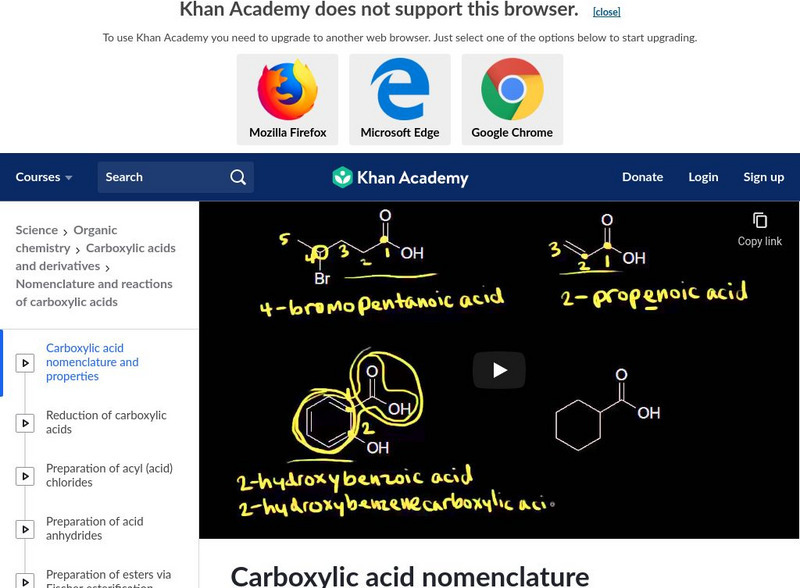Hi, what do you want to do?
Khan Academy
Khan Academy: Aromatic Compounds: Aromatic Stability I
In this video lecture learn about aromaticity or aromatic stabilization. Video focuses on the aromatic molecule of benzene. Understand that aromatic compounds are classified by containing a ring and having a certain number of electrons...
Khan Academy
Khan Academy: Electrophilic Aromatic Substitution Mechanism
A video lecture that discusses the general reaction mechanisms of electrophilic aromatic substitution. [6:54]
Khan Academy
Khan Academy: Nucleophilic Aromatic Substitution
Learn about the addition-elimination mechanism in the nucleophilic aromatic substitution reaction in this video. [9:46]
Khan Academy
Khan Academy: Carboxylic Acid Introduction
Get some introduction information about carboxylic acid in this video. Learn why they are more acidic than alcohol. [8:50]
Khan Academy
Khan Academy: Fisher Esterification
A video introducing the mechanism of a fisher esterification where the esterification of a carboxylic acid occurs. [17:11]
Khan Academy
Khan Academy: Carboxylic Acid Nomenclature and Properties
A video lecture showing you how to name carboxylic acids. Also understand how to analyze the physical properties of the carboxylic acid. [8:51]
Khan Academy
Khan Academy: Nomenclature and Properties of Acyl Halides and Acid Anhydrides
A video lecture showing you how to name acyl (acid) chlorides and acid anhydrides. Also understand how to analyze the physical properties of the acyl (acid) chlorides and acid anhydrides. [10:19]
Khan Academy
Khan Academy: Seismic Waves and How We Know Earth's Structure
This video illustrates and explains how seismic waves function. These waves are broken down into two types: surface and body. Take a look into why waves help understand the structure of Earth. [8:38]
Khan Academy
Khan Academy: Human Evolution: Humanity on Earth
This session travels the earth tracking the evolution of humanity from the age of the dinosaurs through human beings. [12:26]
Khan Academy
Khan Academy: Chronometric Revolution: Measuring Age on Earth
The revolutions of chronometry, the study of time, with respect to measuring time on Earth from forms of writing to radioactivity. [9:54]
Khan Academy
Khan Academy: Detectable Civilizations in Our Galaxy 1: Life in the Universe
A system presented to figure out how many civilations with enough radioactivity to be detected within the Milky Way. [13:03]
Khan Academy
Khan Academy: Introduction to Work and Energy
A video lecture defining working and energy and by giving types of work we can do and what type of energy transferring to an object when doing that work. Understand how work and energy are related. [9:17]
Khan Academy
Khan Academy: Momentum : Introduction to Momentum
A video showing that momentum is the product of mass and velocity. Video contains a simple example problem to show how to calculate. [9:17]
Khan Academy
Khan Academy: Momentum: Ice Skater Throws a Ball
See how the conservation of momentum principles can be applied to a problem of an ice skater throwing a ball. This video lecture gives step by step example. [6:00]
Khan Academy
Khan Academy: Impacts and Linear Momentum: 2 Dimensional Momentum Problem
Solve a collision of balls in two dimensions problem using the conservations of momentum in this video. Video gives a step-by-step explanation of how to solve the problem to figure out what direction and velocity the balls travel after...
Khan Academy
Khan Academy: Momentum: 2 Dimensional Momentum Problem Part 2
Solve a collision of balls in two dimensions using the conservations of momentum in this video. Video discusses how specifically to use trigonometry to solve the direction and velocity of the balls after the collision. [9:32]
Khan Academy
Khan Academy: Moments, Torque, and Angular Momentum: Introduction to Torque
Learn that a torque is applied when a force causes an object to rotate around an axis in this video. Video overviews net torque and how to determine if torque is positive or negative. [9:24]
Khan Academy
Khan Academy: Moments, Torque, and Angular Momentum: Moments
Solve problems by using the Law of Moments in this video. Understand that moments is essentially the same concept as torque as explained in this video. [14:13]
Khan Academy
Khan Academy: Moments, Torque, and Angular Momentum: Moments Part 2
Solve problems by using the Law of Moments in this video. Understand that moments is essentially the same concept as torque as explained in this video. [13:49]
Khan Academy
Khan Academy: Moments, Torque, and Angular Momentum: Angular Momentum
A video exploring angular momentum which is how much movement an object has when it's rotating in a circle. Look at how the equation for angular momentum is derived. [11:18]
Khan Academy
Khan Academy: Constant Angular Momentum When No Net Torque
A video exploring angular momentum which is how much movement an object has when it's rotating in a circle. Look at how the equation for angular momentum is derived when there is no net torque. [5:55]
Khan Academy
Khan Academy: Art History: Nicola and Giovanni Pisano
Video on the thirteenth-century sculptors Nicola and Giovanni Pisano, with biographical and historical information. [13:19]
Khan Academy
Khan Academy: Art History: Parthenon
Video discussing the history of the Parthenon, Athens, 447-432 BC. [10:46] Full episode can be viewed with PBS link. Includes links to additional information and images.
Khan Academy
Khan Academy: Art History: Reformation and Counter Reformation
An overview of the religious ideals of the Reformation and the response of the Catholic Church to the changes sought by the leaders of the Reformation.




























